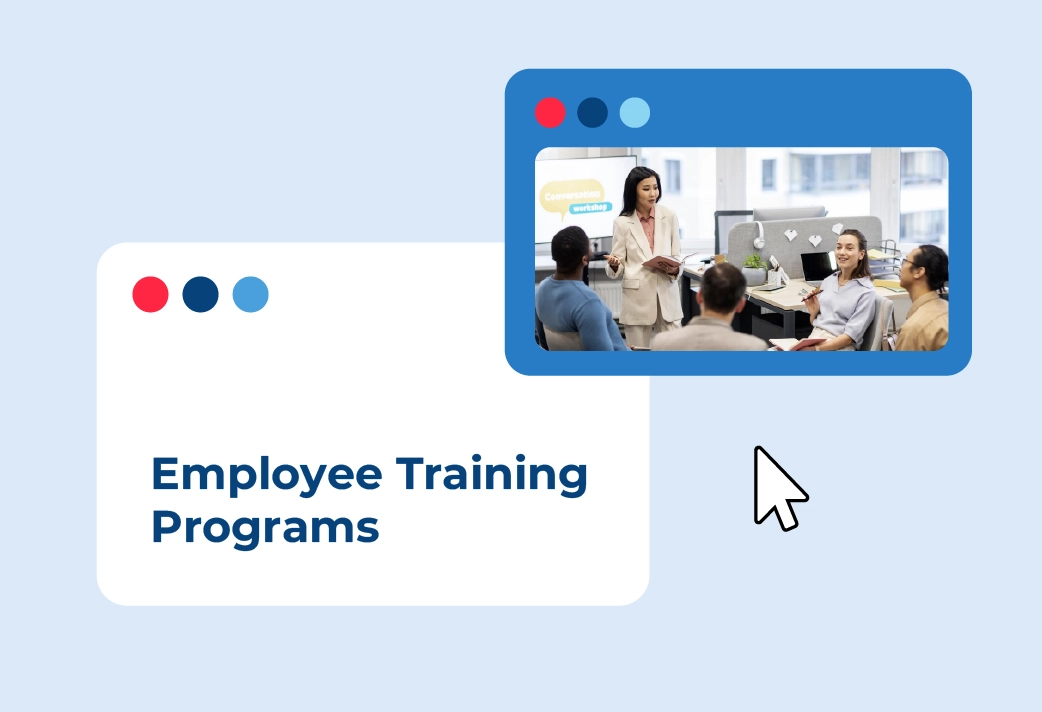Whether it’s onboarding new hires or upskilling existing staff, structured employee training programs play a key role in workforce performance and retention for companies all around the world. As global expansion becomes more accessible to companies of all sizes through solutions like PEO and EOR, understanding how to develop and deliver effective training to increasingly diverse teams of workers from around the world has never been more important.
Effective employee training programs are designed to develop skills, improve job performance, and align employees with company goals. So, in this guide, we’ll explore the essential types of employee training programs, what benefits they offer, and how to build a strategy that supports both local growth and international scalability.

Tired of scrolling? Download a PDF version for easier offline reading and sharing with coworkers
Types of Employee Training Programs
Offering various types of training programs allows businesses to meet the diverse needs of their workforce while fostering growth and engagement. From onboarding to leadership training, each program plays a crucial role in enhancing employee capabilities.
Expanding access to comprehensive training programs empowers employees to thrive in dynamic work environments and strengthens the organization’s long-term success, with Harvard Business School claiming that companies that prioritize training report a 21% boost in productivity and profitability as a result.
For those who train their employee, the benefits are clear, but knowing exactly what kind of training programs will most benefit employees can be hard.
Onboarding and Orientation Training Programs
Introduction to Company Culture and Values
Onboarding programs introduce new employees to the company’s core values, mission, and workplace culture. By sharing insights into the organization’s vision, employees gain a deeper understanding of how their role contributes to overall success.
A strong emphasis on culture fosters alignment, engagement, and loyalty from day one. Through clear communication of company values, employees feel a stronger connection to the organization’s mission, which in turn increases their sense of belonging and commitment to company objectives.
Overview of Company Policies and Procedures
Educating employees about company policies and procedures is critical during onboarding.
Clear explanations of workplace rules, attendance expectations, and code of conduct provide employees with a clear framework for fulfilling their role. Ensuring employees understand internal protocols helps reduce confusion and also fosters positive workplace behaviors.
Comprehensive policy training also enables employees to confidently handle workplace situations by ensuring they understand performance expectations, conduct guidelines, and escalation processes.
Job-Specific Training for New Hires
Tailoring job-specific training ensures new employees develop the skills required to excel in their roles. This may involve hands-on practice, mentorship, or shadowing experienced team members. Providing role-specific guidance helps employees build confidence and adapt quickly to their responsibilities.
Offering tailored resources such as step-by-step guides, video tutorials, opportunities for practice exercises, and mentorship support ensures employees transition smoothly into their new roles while mastering job-related tasks efficiently.
Compliance and Legal Training for New Employees
Compliance training educates employees on essential regulations such as workplace safety, anti-harassment policies, and data protection laws.
This training is crucial for ensuring employees understand their legal responsibilities and workplace rights, reducing risks of non-compliance. By incorporating real-world scenarios and case studies into training, businesses can reinforce the importance of compliance while helping employees apply these guidelines to their day-to-day activities.

Skills Development and Technical Training Programs
Training on Specific Tools, Software, or Equipment
Equipping employees with knowledge of industry-specific tools, software, or machinery enhances productivity and future-proofs key areas of a business, such as payroll or legal compliance.
Providing hands-on practice ensures employees become confident in using these tools effectively in their day-to-day tasks, and by integrating interactive demonstrations, guided tutorials, and real-time practice exercises, employees develop technical proficiency faster, improving overall efficiency and accuracy.
Technical Certifications and Qualifications
Supporting employees in earning technical certifications boosts their expertise and ensures they meet industry standards.
Certifications such as Microsoft Certified Professional, AWS Solutions Architect, or ITIL certification provide employees with credentials that enhance their career prospects and strengthen company capabilities. Encouraging employees to pursue certifications not only raises their skill level but also demonstrates the organization’s commitment to career growth and industry excellence.
Industry-Specific Skills and Knowledge
Training that focuses on industry-specific skills helps employees stay updated with emerging trends and best practices. Industries such as finance, healthcare, and IT frequently require specialized training to ensure staff maintain industry knowledge and adhere to regulations.
Blending theoretical knowledge with practical applications in this way helps employees gain a deeper understanding of industry changes, ensuring their skills remain relevant and competitive over time.
Continuous Professional Development (CPD)
Encouraging continuous professional development (CPD) helps employees pursue ongoing learning opportunities. CPD training may involve workshops, online courses, or industry conferences, ensuring employees remain adaptable and competitive in their fields.
By actively supporting CPD initiatives, businesses demonstrate their investment in long-term employee growth while ensuring their workforce remains skilled and up to date.

Leadership and Management Training Programs
Development of Leadership Skills for Current and Future Managers
Leadership training programs prepare employees for supervisory roles by developing essential management skills. Training often includes guidance on motivating teams, decision-making, and conflict resolution to equip leaders with the tools they need to excel. Providing practical scenarios and interactive role-play exercises enhances the learning experience, helping leaders build the skills necessary to inspire and guide their teams effectively.
Communication and Conflict Resolution Skills
Effective leadership requires strong communication skills and the ability to resolve conflicts constructively.
Training programs that emphasize listening techniques, feedback delivery, and de-escalation strategies enhance managerial effectiveness and promote positive workplace dynamics. By teaching managers how to approach difficult conversations, businesses empower leaders to maintain productive and harmonious work environments.
Training in Decision-Making and Problem-Solving
Teaching leaders effective decision-making and problem-solving strategies empowers them to handle challenges confidently. Simulated scenarios and case studies provide managers with practical experience in evaluating risks and making informed choices.
Encouraging leaders to adopt analytical frameworks for assessing business decisions also ensures they approach complex problems with clarity and precision.
Coaching and Mentoring Programs
Coaching programs help managers guide employees through professional development. By promoting mentorship, leaders learn how to support employees’ growth, address performance issues, and cultivate high-performing teams.
Encouraging managers to adopt a coaching mindset promotes continuous improvement, trust, and stronger employee engagement.

Soft Skills and Interpersonal Training Programs
Training on Communication, Teamwork, and Collaboration
Developing strong communication skills is vital for employees to collaborate effectively and build positive relationships. Training programs that focus on active listening, delivering clear messages, and encouraging feedback help employees engage confidently in teamwork environments.
Employees with these enhanced communication skills can better express their ideas, align with colleagues, and contribute to successful project outcomes.
Emotional Intelligence and Empathy Development
Emotional intelligence (EQ) training equips employees with the skills to manage emotions, demonstrate empathy, and respond thoughtfully to workplace challenges.
EQ development emphasizes self-awareness, self-regulation, and social skills, helping employees build stronger relationships with peers and clients.
Time Management and Organizational Skills
Time management training teaches employees how to prioritize tasks, set realistic deadlines, and maintain focus on key objectives. Effective organizational skills enable employees to manage their workload efficiently, reducing stress and improving productivity. With proven time management strategies, employees can improve task completion rates, meet deadlines consistently, and maintain a healthy work-life balance.
Conflict Management and Negotiation Skills
Training employees in conflict resolution and negotiation techniques helps them address disputes constructively.
Equipping employees with these skills encourages collaboration and ensures conflicts are resolved in a professional and respectful manner.

Compliance and Regulatory Training Programs
Health and Safety Training (OSHA, Workplace Safety, etc.)
Ensuring employees understand health and safety regulations is critical to maintaining a secure workplace. Training programs that address OSHA guidelines or comparative frameworks in other countries, emergency procedures, and proper equipment usage ensure employees can identify hazards and reduce workplace risks.
With adequate safety training in place, businesses create safer environments for everyone, as well as comply with legal safety standards.
Legal Compliance Training (Anti-Discrimination, Labor Laws, etc.)
Compliance training educates employees about workplace laws and regulations, including anti-discrimination policies, equal opportunity practices, and harassment prevention.
With today’s enhanced prioritization of workplace harmony and opportunity for all, businesses reduce the risk of lawsuits and ensure employees understand their rights and obligations by providing training that addresses discrimination in detail. Thorough compliance training also reinforces fair treatment and promotes an inclusive workplace environment in which everyone can thrive.
Data Protection and Privacy Regulations (GDPR, HIPAA)
With increasing concerns over data security, training employees on global data protection frameworks such as GDPR, HIPAA, and other data protection standards is essential. Employees learn best practices for handling sensitive data, ensuring secure communication, and preventing data breaches.
Providing employees with clear guidelines ensures businesses meet regulatory requirements while protecting customer and employee information.
Ethical Training and Corporate Governance
Ethics training is a less common yet increasingly vital part of compliance-focused training that reinforces core values such as integrity, accountability, and transparency.
Teaching employees how to recognize and respond to ethical dilemmas not only ensures consistent decision-making and strengthens corporate culture but also emphasizes the importance of governance policies, which help businesses maintain public trust and uphold professional standards.

Diversity, Equity, and Inclusion (DEI) Training Programs
Understanding Unconscious Bias and Its Impact
Unconscious bias training helps employees recognize internal prejudices that may influence workplace decisions. By addressing these biases, businesses can create fairer hiring practices, improve team dynamics, and promote equity. Understanding unconscious bias encourages employees to embrace diversity and treat colleagues with respect.
Promoting Diversity in the Workplace
Training employees to recognize the value of diverse perspectives enhances creativity, innovation, and team collaboration. Diversity-focused programs emphasize inclusive hiring practices, cultural awareness, and fostering diverse leadership.
Promoting diversity within the workplace builds stronger connections with global audiences and encourages varied viewpoints, something particularly essential for businesses working with cross-border teams.
Creating an Inclusive Culture
An inclusive workplace ensures employees from different backgrounds feel valued and empowered. Inclusion training teaches managers and employees strategies for supporting marginalized groups, promoting equity in decision-making, and ensuring every employee feels their voice is heard. Building an inclusive culture leads to stronger employee engagement and improved retention rates.
Addressing Microaggressions and Promoting Respectful Behavior
Training employees to identify and address microaggressions (intentional or unintentional verbal insults that marginalize groups in a community) helps reduce harmful behaviors in the workplace.
By promoting respect and accountability, employees become more mindful of their interactions and language. Encouraging open discussions and supporting respectful dialogue ensures all employees feel safe and valued.

Customer Service Training Programs
Effective Communication with Clients and Customers
Customer service training equips employees with the skills to communicate effectively with clients. Employees learn techniques for active listening, empathizing with customer concerns, and delivering clear information. By enhancing communication skills, employees improve customer satisfaction and foster stronger client relationships.
Problem-Solving and Conflict Resolution in Customer Service
Customer service employees must develop strong problem-solving skills to address customer concerns effectively. Training programs focus on de-escalation strategies, identifying customer needs, and offering solutions that align with company policies. Equipping employees with these skills ensures customer issues are resolved efficiently and positively.
Handling Difficult Customers or Situations
Difficult customer interactions require patience, professionalism, and adaptability. Training employees in de-escalation techniques, calm communication, and conflict resolution helps them manage challenging scenarios confidently.
Sales and Upselling Techniques
Customer service training often includes sales techniques that encourage employees to identify customer needs and recommend relevant products or services. Employees learn how to introduce upselling opportunities effectively while maintaining trust and ensuring customers feel valued.
Equipping staff with upselling skills contributes to improved revenue growth while also improving the way that employees build long-term relationships with clients.

Sales Training Programs
Product Knowledge and Competitive Landscape
Sales employees require comprehensive product knowledge to address customer questions and showcase product value. Training programs provide employees with detailed insights into product features, benefits, and competitive advantages. By building product expertise, employees can confidently position solutions that meet customer needs.
Sales Techniques and Strategies
Equipping employees with proven sales techniques helps them connect with prospects and close deals effectively. Training programs focus on key strategies such as consultative selling, value-based selling, and rapport-building techniques. Teaching new or improved sales strategies helps employees to become more effective in engaging prospects and addressing objections.
Negotiation and Closing Skills
Sales employees must master negotiation tactics to achieve favorable outcomes while building client trust. Training programs teach employees how to identify client needs, highlight value, and secure agreements, and effective negotiation techniques both improve close rates and ensure lasting customer relationships.
Customer Relationship Management (CRM) Training
Training employees to use CRM systems ensures sales teams manage customer interactions effectively. Employees learn how to track leads, organize client information, and follow up with prospects efficiently. In this way, CRM training ensures businesses improve customer retention and streamline sales processes.

Remote Work and Virtual Training Programs
Effective Communication and Collaboration in Remote Teams
In remote work environments, effective communication is crucial for maintaining team alignment and productivity. Employees should be trained to use clear messaging, active listening skills, and appropriate communication channels to stay connected with colleagues.
Encouraging employees to participate in regular video calls, group chats, and project updates fosters collaboration and prevents misunderstandings. By promoting clear communication practices, businesses ensure remote teams remain cohesive and engaged.
Time Management and Self-Discipline for Remote Workers
Remote employees face unique challenges in managing their time effectively. Training programs that focus on prioritization strategies, goal-setting techniques, and avoiding distractions help employees remain productive when working independently.
Helping employees to create structured routines, set clear daily objectives, and establish boundaries between work and personal time ensures they maintain focus and meet deadlines consistently.
Using Remote Work Tools (Video Conferencing, Project Management Software)
Equipping employees with training on popular remote work tools ensures seamless collaboration. Programs that teach employees how to use platforms like Zoom, Microsoft Teams, and Slack improve communication, while training on project management tools like Trello, Asana, or Monday.com enhances task organization and accountability.
Familiarity with these tools helps remote teams manage workflows, track progress, and achieve goals efficiently.
Virtual Onboarding and Training for Remote Employees
Virtual onboarding introduces remote employees to company culture, policies, and procedures without requiring in-person interaction. Providing online learning modules, interactive video content, and scheduled one-on-one meetings helps new hires adapt quickly to their roles.
By combining digital resources with personalized support, businesses can ensure remote employees feel connected and well-prepared to contribute from day one.

Cross-Training and Job Rotation Programs
Training Employees to Perform Tasks Outside Their Primary Role
Cross-training programs empower employees to take on tasks beyond their primary responsibilities.
It also improves workforce flexibility and ensures essential tasks are completed even during staff absences or transitions.
Developing Versatility and Skill Diversity in Teams
Promoting skill diversity among employees enhances overall team strength. Cross-training encourages staff to develop expertise in multiple areas, enabling them to collaborate across departments. By expanding employees’ skill sets, businesses build resilient teams that can adapt to shifting priorities and evolving project needs.
Enhancing Job Satisfaction and Employee Engagement
Cross-training offers employees the opportunity to explore new roles and expand their capabilities, which promotes engagement and satisfaction. Employees who feel challenged and supported in learning new skills are often more motivated, leading to improved retention and long-term career development.
Ensuring Continuity and Resilience in Business Operations
Training employees to handle multiple roles safeguards business continuity during unforeseen disruptions. By developing a workforce capable of adapting to emergencies or sudden changes, businesses minimize downtime, maintain productivity, and ensure essential processes continue without disruption.

Team Building and Collaborative Training Programs
Exercises to Improve Team Cohesion and Communication
Team-building exercises strengthen relationships, improve communication, and build trust among employees. Activities such as icebreakers, team challenges, and collaboration games encourage employees to engage with one another in a positive and supportive environment.
By fostering camaraderie, businesses create stronger, more cohesive teams.
Group Problem-Solving Activities
Training programs that emphasize group problem-solving allow employees to practice critical thinking while improving collaboration skills. Exercises such as brainstorming sessions, role-play scenarios, and case study challenges help employees develop creative solutions together, improving both teamwork and innovation.
Building Trust and Collaboration Among Team Members
Promoting trust-building exercises helps employees form stronger relationships. By encouraging open communication, shared accountability, and mutual respect, businesses create teams that rely on each other for support. Trust fosters collaboration, ensures smoother project execution, and enhances overall team performance.
Leadership in Teams and Fostering Collective Success
Training managers in team leadership skills equips them to inspire collaboration and align team efforts with company objectives.
Managers learn strategies for setting team goals, motivating employees, and facilitating productive group discussions. By encouraging teamwork and shared success, leaders promote stronger group performance and improved employee morale.
Diversity and Technology Training Programs
Training on Digital Tools and Platforms
Technology is constantly evolving, and employees must remain adaptable. Training programs that focus on digital tools such as cloud-based platforms, collaborative apps, and automation software ensure staff can efficiently manage modern workflows. By developing digital literacy, businesses empower employees to embrace new tools confidently and improve operational efficiency.
Promoting Digital Literacy and Fluency in the Workplace
Fostering digital literacy among employees ensures they can effectively navigate digital environments. Training employees to manage data, communicate securely, and utilize online resources ensures they remain competent and confident in modern workplace settings.
Digital fluency enhances collaboration, improves problem-solving, and encourages technological innovation.
Cybersecurity and Data Protection Training
Ensuring employees are aware of cybersecurity risks is vital for data protection. Training programs that focus on password management, recognizing phishing attempts, and safeguarding confidential information reduce the risk of cyberattacks. Employees who understand cybersecurity best practices are better equipped to protect company assets and maintain data integrity, with studies showing a 70% reduction in phishing attacks when employees receive proper cybersecurity training, among other benefits.
Encouraging Technological Adoption and Innovation
Training programs that encourage employees to embrace digital innovation ensure businesses stay competitive in evolving markets.
By promoting forward-thinking strategies and fostering an openness to new tools and trends, businesses can enhance efficiency, drive innovation, and achieve long-term success.

Career Development and Succession Planning Training
Training for Career Advancement and Growth
Career development programs equip employees with the skills they need to achieve long-term career goals. Training that emphasizes leadership development, skill refinement, and personal growth empowers employees to excel in current roles while preparing for future opportunities.
Offering structured career development programs helps businesses retain ambitious employees seeking upward mobility.
Identifying and Developing Future Leaders Within the Company
Identifying employees with leadership potential is crucial for maintaining continuity and growth. Training programs that focus on decision-making, strategic thinking, and people management help businesses prepare high-potential employees for future leadership roles. Developing future leaders internally strengthens team morale and reduces the costs associated with external recruitment.
Mentoring Programs to Support Career Progression
Establishing mentorship programs allows experienced employees to guide and support junior staff. Mentors provide valuable insights, offer career advice, and help mentees develop critical workplace skills.
Mentorship programs enhance knowledge transfer, improve employee engagement, and foster positive relationships within the organization, all of which build employee satisfaction and retention over time.
In fact, companies that demonstrate a commitment to retraining and upskilling employees not only see a boost in immediate effectiveness, but also see considerably less job searching by employees (up to 47% less according to one poll) who would otherwise be looking elsewhere for the next step on their career ladder.
Cross-Functional Training for Leadership Readiness
Cross-functional training prepares employees to manage multiple business areas by exposing them to diverse tasks and responsibilities. Training employees to understand different departments enhances leadership readiness, improves collaboration, and strengthens overall business continuity.
This approach equips future leaders with the well-rounded expertise needed to oversee complex organizational structures.
Maximize Employee Growth with INS Global
According to Devlin Peck, 59% of employees polled said that they believed training to be directly impactful on their job performance. Whether or not this translates into a real productivity boost, even the fact that employees notice and appreciate training should be enough to help you consider how to best integrate employee training programs into the workplace.
Creating effective employee training programs is crucial for improving workforce skills, boosting engagement, and supporting long-term business growth, but offering this training as a benefit and managing these programs on the global stage can be difficult. That’s why partnering with INS Global helps ensure businesses develop customized cross-border training strategies that both align with organizational goals and employee needs.
Since 2006, INS Global has been offering tailored, expert support to businesses of all sizes who want to take the next step on their global expansion journey. We offer solutions that streamline and secure global recruiting, payroll, contract management, HR, and more, all of which make it easier to further your expansion strategy by taking care of the common and uncommon complications that come with growth.
Contact INS Global today to discover tailored training solutions that empower your workforce and drive business success.



SHARE